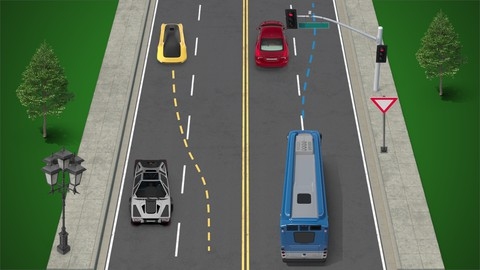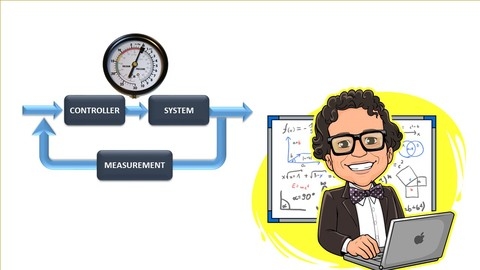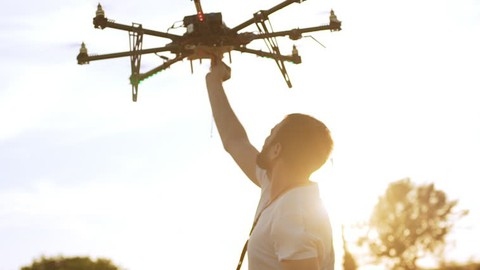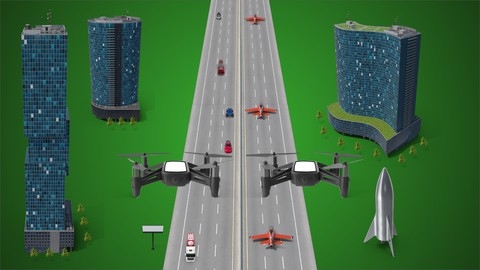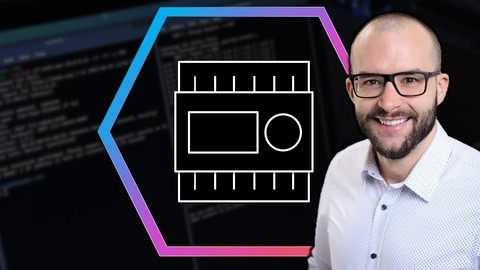Control systems are the backbone of modern technology, enabling everything from self-driving cars to sophisticated industrial processes.
Understanding control systems equips you to design, analyze, and optimize systems that achieve desired behavior and performance.
By learning control systems, you can unlock exciting career opportunities in fields like robotics, aerospace, and automation.
Finding a good control systems course on Udemy can be overwhelming, with so many options available.
You want a course that’s both comprehensive and engaging, providing a solid foundation in theory while offering practical applications.
You’re also looking for a course taught by experienced instructors who can guide you through the complexities of this vital field.
For the best control systems course overall on Udemy, we recommend Applied Control Systems 1: autonomous cars: Math + PID + MPC.
This course stands out for its focus on real-world applications, using autonomous cars as a compelling example to illustrate key concepts.
You’ll gain hands-on experience with Python programming, simulating systems and implementing controllers.
This course is ideal for those interested in robotics, automotive engineering, or anyone seeking a practical introduction to control systems.
While Applied Control Systems 1: autonomous cars: Math + PID + MPC is our top pick, there are other great options on Udemy catering to different learning levels and interests.
Keep reading to explore our recommendations for beginners, intermediate learners, and experts, as well as courses focusing on specific control techniques and applications.
Applied Control Systems 1: autonomous cars: Math + PID + MPC
“Applied Control Systems 1: Autonomous Cars: Math + PID + MPC” offers a comprehensive introduction to the world of controlling vehicles.
You’ll embark on a journey from basic control concepts to advanced techniques used in autonomous vehicles.
The course starts with the fundamentals of open and closed-loop systems and then dives into practical applications.
You’ll learn how to model real-world systems like water tanks and magnetic trains using Python.
Imagine using a few lines of code to adjust the water level in a tank or control the speed of a train!
You’ll learn how to simulate these systems with Python libraries like Numpy and Matplotlib, visualizing the results and gaining a deeper understanding of how control systems work.
A key focus of the course is on Proportional-Integral-Derivative (PID) controllers, a common and powerful tool for controlling systems.
You’ll learn the theory behind PID controllers and how to implement them in Python.
You’ll also be introduced to Model Predictive Control (MPC), a cutting-edge technique used in autonomous vehicles.
MPC allows you to predict the future behavior of a system and optimize its control based on those predictions.
You’ll learn the core principles of MPC and how to apply them to control the lateral movement of a car, an essential skill for building self-driving vehicles.
You’ll understand how to design and implement control algorithms for real-world applications and gain practical experience in programming with Python.
You’ll also learn how to set up Python environments on different operating systems like Windows, macOS, and Linux.
This course provides a strong foundation in control systems theory, practical programming skills, and a glimpse into the future of autonomous vehicles.
It’s an ideal stepping stone for anyone interested in pursuing careers in robotics, automotive engineering, or related fields.
Control Systems Made Simple | Beginner’s Guide
“Control Systems Made Simple” provides a solid foundation in the fundamentals of control systems, making it an ideal starting point for anyone seeking an introduction to this field.
You’ll gain hands-on experience with essential engineering tools like Simulink and MATLAB throughout the course, applying them to real-world scenarios.
The course expertly guides you through the modeling of mechanical systems, beginning with basic elements like mass, springs, and dampers.
You’ll then progress to simulating more complex systems, such as a train system, deepening your understanding of dynamic behavior.
The curriculum seamlessly transitions to electrical systems, covering fundamental concepts and introducing you to the world of battery modeling, including charging methods and different model types.
You’ll acquire practical experience simulating these models using MATLAB, a powerful tool for engineers.
The core of the course focuses on control systems, introducing you to the essential concepts of PID controllers.
You’ll learn to develop your own PID controller logic within Simulink and apply it to control a mass-spring-damper system.
The course’s strength lies in its practical approach, evidenced by two detailed examples.
One delves into the modeling and control of a stage system, while the other focuses on controlling the position of a DC motor.
These examples provide valuable real-world application of the concepts you learn.
Control Systems: From Mathematical Modelling to PID Control
You’ll begin by learning to represent real-world systems mathematically, exploring the interactions between systems and signals.
The course delves into the intricacies of mechanical and electromechanical systems, equipping you with the skills to model their behavior and predict their responses.
Next, you’ll discover the power of Laplace transforms as a tool for solving complex linear differential equations.
The course emphasizes system dynamics, a crucial aspect of control systems, and introduces you to transfer functions and block diagrams as methods for system representation.
These concepts lay the groundwork for understanding stability, a key principle in control theory, and open the door to the realm of feedback control.
The course then explores various control techniques, starting with open loop control and progressing to closed-loop control.
You’ll learn to achieve desired system responses through controller design, focusing on proportional (P), proportional-integral (PI), and proportional-derivative (PD) controllers.
The course even introduces the renowned Ziegler-Nichols method for designing PID controllers.
A particularly engaging aspect of the course is the opportunity to apply your knowledge by modeling a car and designing a PID controller using MATLAB/SIMULINK.
This hands-on experience will solidify your understanding and allow you to test your skills in real-world scenarios.
While the course covers a wide range of topics, it’s important to note that it’s designed for a beginner to intermediate level understanding.
Those with prior knowledge of control systems may find certain aspects of the course to be a review.
However, the practical applications and the use of industry-standard software like MATLAB/SIMULINK make it a valuable resource for anyone seeking to gain a solid foundation in this field.
Applied Control Systems 3: UAV drone (3D Dynamics & control)
If you’re looking to dive deep into the intricate world of drone control, “Applied Control Systems 3: UAV Drone (3D Dynamics & Control)” offers a comprehensive and engaging exploration of the mathematics and physics behind these fascinating machines.
This course goes beyond simply making drones fly; it equips you with a profound understanding of the complex systems that govern their every movement.
You’ll begin by deconstructing the drone’s architecture from a control systems perspective.
This includes exploring the distinctions between inertial and body frames, understanding how to define the inputs and outputs of a 6 DOF (degrees of freedom) drone, and delving into the intricacies of propeller rotation directions for both fixed-wing drones and helicopters.
This foundational knowledge lays the groundwork for mastering the four key control actions: thrust, roll, pitch, and yaw.
Each action is meticulously explained, accompanied by exercises and solutions to reinforce your comprehension.
The course then takes you on a journey into the fundamental equations that govern a 6 DOF system.
You’ll learn the principles of Newton-Euler equations, distinguish between kinematics and dynamics, and master the use of matrices and Euler angles to measure the drone’s position, attitude, and orientation.
You’ll also explore the concepts of mass moments of inertia and inertia tensors, crucial for understanding how forces affect the drone’s rotation.
The course culminates in the development of a state-space model for the UAV, incorporating elements like gyroscopic effects, gravity, and control inputs.
You’ll learn about different numerical integration methods, such as Euler and Runge-Kutta, and how they’re applied to simulate the drone’s behavior.
You’ll also delve into blade element theory, which models the relationship between control inputs and rotor angular velocities.
Throughout the course, you’ll have the opportunity to apply your newfound knowledge through hands-on Python simulations.
This allows you to experiment with different control strategies and observe their impact on the drone’s trajectory.
You’ll also learn about Model Predictive Control (MPC) and its application to the UAV, including how to manage constraints.
Mastering Control Systems : Very basics to Advance for 2021
You’ll start by mastering control systems building blocks: transfer functions, which act as mathematical blueprints for system behavior.
You’ll explore the differences between open-loop and closed-loop systems, gaining insights into how systems are controlled.
Block diagrams, the visual language of control systems, will become your tools for representing complex systems.
Beyond the fundamentals, you’ll delve into powerful analytical methods.
The Laplace Transform will transform real-world systems into mathematically manageable functions, enabling analysis and design.
Time-domain analysis will help you understand how systems respond over time, including crucial concepts like stability, essential for reliable system performance.
One of the highlights is the Root Locus method.
This visual tool allows you to see how the poles of a system change as you adjust controller parameters.
You’ll learn to use this method to design controllers that achieve optimal system performance.
Furthermore, frequency domain analysis will equip you to understand how systems respond to different frequencies, helping you design robust systems that can handle noise and disturbances.
The course concludes with state-space analysis, a more advanced modeling approach.
You’ll learn to create state-space models and apply them to analyze and design control systems.
Topics like controllability and observability will introduce you to critical aspects of system control and monitoring.
While this course offers a thorough introduction to control systems, it’s important to note that some aspects may require additional exploration outside of the course to fully grasp their complexities.
However, the foundation you’ll gain will enable you to confidently tackle a wide range of control systems challenges in real-world applications.
Applied Control Systems 2: autonomous cars (360 tracking)
This course offers a comprehensive dive into the exciting world of autonomous vehicle control, specifically focusing on enabling vehicles to track objects in a 360-degree environment.
You’ll embark on a journey that starts with the foundational principles of control systems, exploring equations of motion and state-space representations, crucial for understanding how to command a car.
You’ll then be introduced to the powerful techniques of Model Predictive Control (MPC) and Linear Parameter Varying (LPV) methods, key players in designing controllers that can adapt to changing conditions.
The course delves into the practical aspects of implementing MPC, guiding you through formulating constraints for the controller and employing cubic polynomials to generate smooth trajectories.
You’ll gain hands-on experience using powerful Python libraries like Qpsolvers and cvxopt to solve optimization problems and build your MPC controller.
You’ll even utilize Matplotlib to visualize the results of your simulations, bringing your learning to life.
The syllabus provides a detailed code explanation section, leading you step-by-step through the implementation of the LPV-MPC controller in Python.
Assessing and Protecting Industrial Control Systems
Imagine diving into the world of Industrial Control Systems (ICS), also known as Operational Technology (OT), and learning how to assess and protect these critical systems from cyberattacks.
This course gives you the tools and knowledge to do just that.
You’ll start by understanding the key differences between IT and OT networks, setting the stage for your journey into the world of ICS security.
You’ll then explore how to identify vulnerabilities in ICS/OT systems using real-world tools like Nmap, a powerful network scanner, and learn how to map out these systems to pinpoint potential attack points.
But the course goes beyond theory.
You’ll get hands-on experience setting up a virtual lab using VirtualBox and Kali Linux, a popular penetration testing distribution.
The course delves deeper, focusing on the security of Programmable Logic Controllers (PLCs), essential components in many industrial control systems.
You’ll learn how to use Nmap and other tools to scan for open ports, identify potential vulnerabilities, and even simulate attacks on PLCs.
The course also covers Human-Machine Interfaces (HMIs), the user interfaces operators use to interact with PLCs, providing you with the skills to assess their security vulnerabilities.
This course keeps you at the forefront of ICS security by introducing cutting-edge concepts like ICS ATT&CK, a framework for understanding common attack techniques against industrial control systems.
You’ll learn how to analyze real-world threats and develop strategies for mitigating them.
You’ll also delve into HAZOP (Hazard and Operability Study) and the Use Case Abuse Model, powerful techniques for identifying and mitigating potential risks in ICS environments.
Finally, you’ll learn how to create detailed reports summarizing your findings and presenting recommendations for improving ICS/OT security.
You’ll put all your learned skills to work, showcasing your expertise by developing robust security plans.
This course provides a comprehensive approach to ICS/OT security, covering everything from identifying potential threats to implementing specific protection techniques.
Ready to take your ICS/OT security skills to the next level?
This course offers the practical knowledge and hands-on experience you need to excel in this rapidly evolving field.
